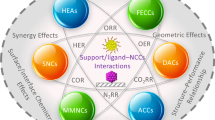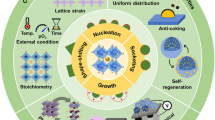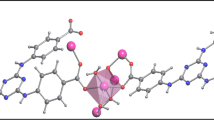Abstract
Three-dimensional self-assembled rugby-ball-shaped microarchitectures of tetragonal Na0.5La0.5MoO4:Eu3+ crystal structure were synthesized by facile hydrothermal method at 200°C for 8 h using ethylenediaminetetraacetic acid (EDTA) as surfactant. Structure and morphology of Na0.5La0.5MoO4:Eu3+ were investigated by X-ray diffraction and scanning electron microscopy. In the hydrothermal process, EDTA not only acts as a chelating reagent to facilitate the formation of Na0.5La0.5MoO4:Eu3+ but also acts as a surface capping agent to adhere to the newly created surface and to promote crystal splitting. The molar concentration of EDTA plays an important role and can effectively tune the size of the particles. Photoluminescence study reveals that hierarchical structures of Na0.5La0.5MoO4:Eu3+ show a strong emission in the red region under 395-nm UV excitation.
Similar content being viewed by others
Avoid common mistakes on your manuscript.
Background
Homogenous and self-aggregated three-dimensional (3D) superstructures with uniform size distribution have attracted interest nowadays because of their aberrant behavior that tailors the physical and chemical properties of materials resulting from momentous advancement that has been developed for the fabrication of a new class of micro- and nanostructured devices [1, 2]. The peculiar size-dependent properties of 3D hierarchical networks have initiated worldwide intense research to material scientists in different fields of applications such as opto-electronics, catalysts, display devices, and fluorescent probes for biological staining [3, 4]. Recently, the interests have been expanded into controlling the shape of micro/nanomaterials and also in understanding the correlations between the material shape and their properties. Sheaf-like orthorhombic Gd2(MoO4)3:Eu3+ nanostructures [5], ordered shuttle-like NaLa(MoO4)2:Eu3+ nanorods composed of nanoparticles [6], self-assembled 3D flower-like NaY(MoO4)2:Eu3+ microarchitectures [7], and 3D bowknot-like hierarchical microstructures Y2(WO4)3:Ln3+[8] are the few examples of the shape-controlled synthesis of 3D networks. Therefore, the development of a reliable and convenient synthetic route that can control the shape of nanostructures under ambient conditions remained an important research topic of investigation.
It is well known that among the various solution-phase techniques, the hydrothermal route has been exclusively investigated as a promising alternative technique for the fabrication of three-dimensional hierarchical structures under mild synthesis and feasible environment [9]. The reason is that this method is fast, simple, economical, and environment friendly [10]. Recently, scheelite-type crystalline structures of molybdate or tungstate compounds, in which Mo6+ or W6+ ions are coordinated tetrahedrally, show promising applications in the field of opto-electronics and laser technology [11, 12]. The compounds with the general formula Na0.5R0.5MoO4 (where R = La3+, Gd3+) possess the tetragonal scheelite structure in which Na+ and R3+ jointly occupied the dodecahedral positions and the Mo6+ ions are at the centers of the tetrahedral symmetry [13]. Recently, europium-activated molybdates are more attractive due to strong red light emission under 393- to 464-nm excitations [14], and Eu3+ has been extensively studied in rare-earth ions due to its unique spectral character that shows enriched emission in various host materials.
With this view, we have reported Na0.5La0.5MoO4:Eu3+ rugby-ball-shaped microarchitectures prepared by the hydrothermal route at 200°C for 8 h by modulating the ethylenediaminetetraacetic acid (EDTA) molar concentrations. The structure and phase purity of the samples were analyzed using X-ray diffraction (XRD) patterns. The characteristic vibrational behaviors of elements were analyzed by Fourier transform infrared spectrometry (FTIR). The final product morphology was examined by scanning electron microscopy (SEM) analysis, and the room-temperature photoluminescence properties of Na0.5La0.5MoO4:Eu3+ were investigated.
Results and discussion
Structural and morphological investigation
Figure 1 shows the XRD pattern of Na0.5La0.5MoO4:Eu3+ prepared by the hydrothermal method by modulating molar concentrations of EDTA. All the peaks are good in agreement with the standard JCPDS card no. 79–2243 of Na0.5La0.5MoO4. It is clearly seen from the XRD that the as-synthesized products are highly crystalline and they belong to tetragonal phase with scheelite structure of the space group I41/a.
Figure 2a,b,c,d,e,f indicates the low- and high-magnification SEM images of Na0.5La0.5MoO4:Eu3+ rugby-ball-shaped structures which were synthesized by modulating the amount of EDTA with a fixed Na+, [La3+/Eu3+]. When the molar ratio of EDTA was 1 mM, microspheres with an average length of 2.3 μm and diameter of 1.20 μm (Figure 2a) were obtained. The SEM image of the sample synthesized with 1.25 mM EDTA shows rugby-ball-shaped microstructures with an average length of 2.1 μm and diameter of 1.1 μm (Figure 2b). When the amount of EDTA was increased to 1.50 mM, the size of the particle was further reduced, showing an average length of 2.0 μm and diameter of 1 μm (Figure 2c,d). At 1.75 mM concentration of EDTA, the size was further reduced to an average length of 1.8 μm and diameter of 850 nm (Figure 2e). Still when the amount of EDTA was increased to 2.0 mM, the size of the particle was further reduced to 800 nm in length and 350 nm in diameter (Figure 2f). The increase in EDTA concentration enhances the chelating ability of the EDTA molecule that will lead to the reduction of particle size. Hence, it was found that the amount of EDTA introduced to the reaction system had a great influence on the morphology and size distribution of the final products. It could be seen from the SEM images that even a small change in the molar concentration of EDTA shows an extreme impact on the size and morphology of the final product. As a representative result, Na0.5La0.5MoO4:Eu3+ prepared with 1.50 mM of EDTA was taken for FTIR and photoluminescence studies.
FTIR analysis
Figure 3 shows the FTIR transmittance spectra of the Na0.5La0.5MoO4:Eu3+ rugby-ball-shaped structure prepared with 1.50 mM of EDTA. It consists of a strong and broad absorption band starting from 700 to 850 cm-1, and it was assigned to the stretching vibrations of O-Mo-O in the MoO42- group [15]. This absorption band was assigned to the antisymmetric stretch F2 (ν3) of the scheelite tetragonal crystalline structure. The weak absorption at 1,407 cm-1 is assigned to the CH2 group, and the sharp absorption at 1,572 cm-1 is due to H-O-H bending vibration of the absorbed water from air. In addition, the wide bands corresponding to O-H stretch vibrations were observed around 3,358 cm-1.
Photoluminescence studies
Figure 4 shows the room-temperature PL excitation and emission spectra of Na0.5La0.5MoO4:Eu3+ rugby-ball-shaped microstructures, showing a number of characteristic intra-configurational f-f transitions of Eu3+ that appeared in the wavelength region 350 to 450 nm. These characteristic configurations were assigned to the transition from ground state (7F0) to the Eu3+ upper excited states (5D4,3 and L6,7), i.e., 7F0 → 5D4 (362 nm), 7F0 → 5L7 (382 nm), 7F0 → 5L6 (395 nm), and 7F0 → 5D3 (416 nm). While exciting with 395-nm UV irradiation, the emission spectra are dominated by the hypersensitive red emission (612 nm), showing the transition 5D0 → 7F2 (due to electric-dipole transition). The other transitions, 5D0 → 7F1 (magnetic-dipole transition), 5D0 → 7F3, and 5D0 → 7F4, are relatively weak. The presence of strong luminescent intensity indicates the good crystalline nature of Na0.5La0.5MoO4:Eu3+ rugby-ball-shaped microstructures.
Conclusions
Self-assembled 3D superstructures of Na0.5La0.5MoO4:Eu3+ were successfully synthesized using hydrothermal route under mild synthesis condition with different molar concentrations of capping agent (EDTA). The hierarchical architectures of Na0.5La0.5MoO4:Eu3+ belong to the scheelite tetragonal structure with the space group I41/a. The FTIR results confirm the presence of stretching vibrations of metal-oxygen bands. The SEM images clearly indicate that the final product consists of rugby-ball-shaped microstructures with uniform size distribution. The molar ratio of EDTA introduced to the reaction system had a great influence on the morphology and size distribution of the particles. The photoluminescence study reveals that upon 395-nm UV excitation, the Na0.5La0.5MoO4:Eu3+ crystal structure shows strong emission in the red region at 615 nm. These results may be important for the synthesis of three-dimensional networks to fabricate new class of micro/nanostructures.
Methods
Synthesis of rugby-ball-shaped 3D hierarchical structures of Na0.5La0.5MoO4:Eu3+
All the chemicals were purchased from Sigma-Aldrich (St. Louis, MO, USA) with 99.99% purity. In the typical synthesis, the stoichiometric amount of Na2MoO4 was first dissolved in 30 mL of double-distilled water under vigorous stirring. Then, LaCl3 and EuCl3 were prepared by dissolving the corresponding rare-earth oxides (La2O3, Eu2O3) in diluted hydrochloric acid and stirred for 15 min. In order to remove the excess HCl, the solution was heated to 60°C to 80°C for 30 min. Then the separate rare-earth chloride solution was carefully mixed with the Na2MoO4 solution, and a white colloidal precipitate was obtained under vigorous stirring for 30 min. Finally, 1 to 2 mM of EDTA was dissolved in 20 mL of double-distilled water, and it is added to the resultant colloidal solution. Then the pH value of the final product was consequently adjusted to 7 by adding NaOH solution. After additional agitation for 30 min, the as-obtained white colloidal precipitate was transferred into a 100-mL Teflon autoclave, sealed in a stainless steel vessel, and heated at 200°C for 8 h. Subsequently, the autoclave was allowed to cool at room temperature, and the resultant solid products were centrifugally separated from the suspension, washed with distilled water and absolute ethanol several times, and dried at 60°C in air for 5 h.
Characterization
The XRD patterns were recorded on Philips X’Pert PRO system from PANalytical’s diffractometer (Almelo, The Netherlands) with Cu Kα radiation (λ = 0. 15406 nm) and a scanning rate of 0.05° s-1. Morphology and elemental composition of the product were investigated by SEM (JEOL JSM-840, Akishima-shi, Japan). FTIR measurements were carried out in Nicolet 6700 FTIR (Waltham, MA, USA) equipped with a deuterated triglycine sulfate detector. Furthermore, the room-temperature photoluminescence properties of the sample were measured using a Horiba-Jobin Yvon nanolog spectrofluorometer (Kyoto, Japan).
References
Law M, Sirbuly DJ, Johnson JC, Goldberger J, Saykally RJ, Yang PD: Nanoribbon waveguides for subwavelength photonics integration. Science 2004, 305: 1269–1273. 10.1126/science.1100999
Duan H, Wang D, Sobal NS, Giersig M, Kurth DG, M’ohwald H: Magnetic colloidosomes derived from nanoparticle interfacial self-assembly. Nano Lett. 2005, 5: 949–952. 10.1021/nl0505391
Hu JT, Ouyang M, Yang PD, Lieber CM: Controlled growth and electrical properties of heterojunctions of carbon nanotubes and silicon nanowires. Nature 1999, 399: 48–51. 10.1038/19941
Shen J, Sun LD, Yan CH: Luminescent rare earth nanomaterials for bioprobe applications. Dalton Trans. 2008, 42: 5687–5697.
Thirumalai J, Krishnan R, Shameem Banu IB, Chandramohan R: Controlled synthesis, formation mechanism and luminescence properties of novel 3-dimensional Gd 2 (MoO 4 ) 3 :Eu3+ nanostructures. Mater Sci. Mater Electron. 2013, 24: 253–2599. 10.1007/s10854-012-0725-6
Yang M, You H, Jia Y, Qiao H, Guo N, Song Y: Synthesis and luminescent properties of NaLa(MoO 4 ) 2 :Eu3+ shuttle-like nanorods composed of nanoparticles. Cryst. Eng. 2011, 13: 4046–4052. 10.1039/c0ce00822b
Huang Y, Zhou L, Yang L, Tang Z: Self-assembled 3D flower-like NaY(MoO 4 ) 2 :Eu3+ microarchitectures: hydrothermal synthesis, formation mechanism and luminescence properties. Opt. Mater. 2011, 33: 777–782. 10.1016/j.optmat.2010.12.015
Huang S, Zhang X, Wang L, Bai L, Xu J, Li C, Yang P: Controllable synthesis and tunable luminescence properties of Y 2 (WO 4 ) 3 :Ln3+ (Ln = Eu, Yb/Er, Yb/Tm and Yb/Ho) 3D hierarchical architectures. Dalton Trans. 2012, 41: 5634–5642. 10.1039/c2dt30221g
Fang YP, Xu AW, You LP, Song RQ, Yu JC, Zhang HX, Li Q, Liu HQ: Hydrothermal synthesis of rare earth (Tb, Y) hydroxide and oxide nanotubes. Adv. Funct. Mater. 2003, 13: 955–960. 10.1002/adfm.200304470
Dhas NA, Suslick KS: Sonochemical preparation of hollow nanospheres and hollow nanocrystals. J. Am. Chem. Soc. 2005, 127: 2368–2369. 10.1021/ja049494g
Ryu JH, Yoon JW, Lim CS, Oh WC, Shim KB: Microwave-assisted synthesis of CaMoO 4 nano-powders by a citrate complex method and its photoluminescence property. J. Alloy Compd. 2005, 390: 245–249. 10.1016/j.jallcom.2004.07.064
Gong Q, Qian X, Cao H, Du W, Ma X, Mo M: Novel shape evolution of BaMoO4 microcrystals. J. Phys. Chem. B 2006, 110: 19295–19299. 10.1021/jp0634205
Kuz’micheva GM, Rybakov VB, Panyutin VL, Zharikov EV, Subbotin KA: Symmetry of (Na0.5R0.5) MO4 crystals (Ra = Gd, La; M = W, Mo). Russ. J. Inorg. Chem. 2010, 55: 1148–1453.
Zheng Liang W, Hong Bin L, Liya Z, Jing W, Meng Lian G, Qiang S: NaEu0.96Sm0.04(MoO4)2 as a promising red-emitting phosphor for LED solid-state lighting prepared by the Pechini process. J. Lumin. 2008, 128: 147–154. 10.1016/j.jlumin.2007.07.001
Frost RL, Cejka J, Dickfos MJ: Raman and infrared spectroscopic study of the molybdate containing uranyl mineral calcurmolite. J. Raman Spectrosc. 2008, 39: 779–785. 10.1002/jrs.1897
Acknowledgements
The authors gratefully acknowledge Alagappa University, Karaikudi, and CUSAT (Saif), Cochin, for extending their instrumentation facilities for characterization.
Author information
Authors and Affiliations
Corresponding author
Additional information
Competing interests
The authors declare that they have no competing interests.
Authors’ contributions
RK synthesized the materials and carried out all the characterization studies. JT participated in the sequence alignment, drafted the manuscript, conceived of the study, and participated in its design and coordination. SB and AJ participated in the sequence alignment. All authors read and approved the final manuscript.
Authors’ original submitted files for images
Below are the links to the authors’ original submitted files for images.
Rights and permissions
Open Access This article is distributed under the terms of the Creative Commons Attribution 2.0 International License ( https://creativecommons.org/licenses/by/2.0 ), which permits unrestricted use, distribution, and reproduction in any medium, provided the original work is properly cited.
About this article
Cite this article
Krishnan, R., Thirumalai, J., Banu, I.B.S. et al. Rugby-ball-shaped Na0.5La0.5MoO4:Eu3+ 3D architectures: synthesis, characterization, and their luminescence behavior. J Nanostruct Chem 3, 14 (2013). https://doi.org/10.1186/2193-8865-3-14
Received:
Accepted:
Published:
DOI: https://doi.org/10.1186/2193-8865-3-14








